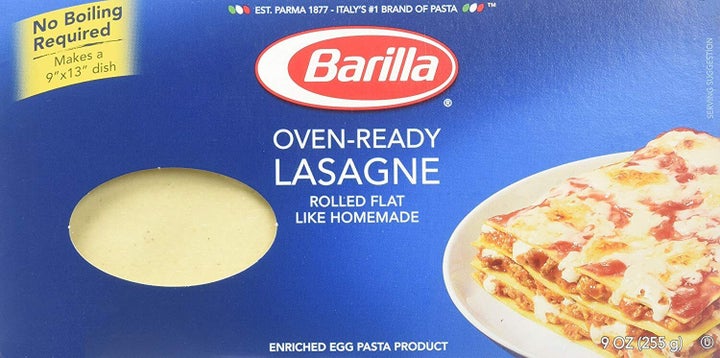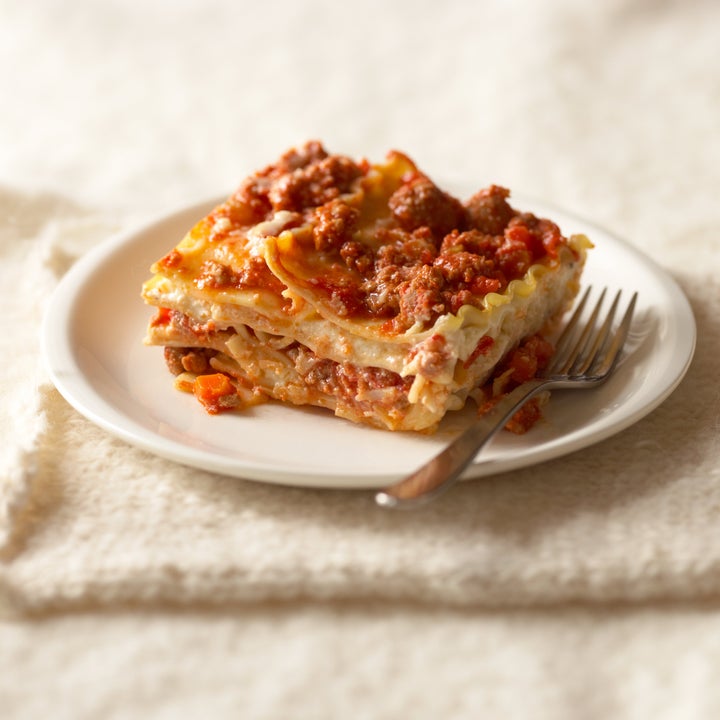When it comes to lasagna that meets the approval of even the most discerning of nonnas, “simple” and “fast” aren’t usually relevant adjectives. It’s often a labor of love, made from daylong sauces, handmade pasta and a work-intensive process of layering everything together.
In an effort to save some time and energy, many Italian cooks have made peace with sheets of dried lasagna noodles, appreciating their efficiency in comparison to hand-rolled dough sheets. However, they still need to be boiled, which can be a little time-consuming and potentially sticky.
But modern food technology operates around one clear ethos: There’s always another shortcut. That’s why no-boil lasagna noodles, which are layered into your dish raw and come out of the oven fully cooked, are making a major splash among American consumers. Sometimes you’ll see them labeled as “no-boil” lasagna noodles, other times they’re called “oven-ready.” But how do these magical boil-free noodle sheets work, and what do trained chefs think of this speedy product?
We asked a group of kitchen experts to offer their opinions on no-boil lasagna noodles, and they provided us with a useful list of pros and cons well worth considering before your next grocery trip.
What are no-boil noodles, and how do they work?
HuffPost consulted culinary scientist and cookbook author Jessica Gavin for an overview of how no-boil noodles are made.
“Food manufacturers have figured out a clever process in pasta-making to eliminate one of the most laborious steps to preparing lasagna,” she said. “To make the pasta sheets no-boil and oven-ready, the ingredients are mixed, extruded to create the long shape, then sent through a water bath. This step gently precooks the pasta, which is then mechanically dehydrated to what consumers see at the grocery store.”

In terms of ingredients and nutritional value, Gavin explains that both no-boil and standard dry lasagna use similar ingredients for a pasta base: semolina wheat, durum wheat flour and water, often enriched with iron and B vitamins. Some no-boil noodle formulas may also contain eggs, but the general nutrition facts for the two types remain very similar.
If you’re wondering how no-boil noodles can possibly end up cooked when your lasagna comes out of the oven, Gavin has the answer. “When the no-boil noodle sheets are layered in between wet ingredients like sauce and ricotta cheese and then baked, they act like a sponge. The dried pasta begins to absorb the water from the surrounding ingredients, rehydrating and softening to a sturdy yet tender texture over time.”
She says that covering the baking dish with foil helps to further steam the noodles, and that using a “wet” tomato-based sauce works better than something like alfredo sauce, which tends to be on the thicker, dryer side.
Pro: No-boil noodles take the guesswork out of lasagna-making
One of the most challenging aspects of lasagna-building involves the delicate balance of a soft center and those appealingly crunchy edges. Boiling noodles ahead of time can cause complications: If the lasagna sheets are over-boiled even a little bit, they’ll interfere with the texture of the dish as a whole.
Luckily, recipe developer Jessica Formicola of Savory Experiments sees no-boil noodles as a simple way to sidestep that problem: “I almost exclusively use no-bake lasagna noodles these days. They save time and, quite often, also prevent the pasta from being overcooked and mushy. Plus, you still get the crispy edges.”
Pro: As long as you avoid overcooking, no-boil noodles are an easy and consistent lasagna solution
The appeal of no-boil lasagna noodles comes courtesy of their expedience and their consistency. That said, it’s still important to watch your oven timer and to ensure that you’re baking your lasagna for the proper duration. “No-boil noodles hold a nice texture ― just make sure you don’t overcook the dish,” said executive chef Walter Pisano of Tulio in Seattle. “While we always make our pasta from scratch at Tulio, the everyday home cook may not have the time or energy to do that, so I’d recommend they give these no-boil noodles a try. It’s a quick way to make a homemade meal for the family on the fly.”
Pro: High-quality no-boil noodles are out there
Gian Paolo Bruschi, a trained chef who currently consults for New York City restaurants D.O.C. Wine Bar and Norma Gastronomia Siciliana, insists there are perfectly good options for no-boil noodles out there.

“I maintain that the no-boil lasagna has reached a quality level that is quite elevated and almost indistinguishable from the traditional fresh homemade lasagna,” Bruschi told HuffPost. “When comparing good quality no-boil lasagna noodles with homemade lasagna noodles made with Italian ingredients, there is no significant difference in taste. However, when using the no-boil lasagna noodle, the cook has to pay attention to the process.” If you’re using a dry sauce like a bechamel, Bruschi suggests adding a little more liquid to help the no-boil sheets better soak up the moisture.
Formicola swears by Barilla’s Oven-Ready Lasagne. “Never had them go wrong!”
Con: No-boil noodles lack surface starch, causing structural issues for the lasagna
A major downside involves the lack of starch produced by no-boil pasta sheets. Boiled noodles release a layer of starch, which helps the sauce, cheese and other lasagna accouterments adhere to the pasta. “[No-boil noodles] are par-cooked for convenience, but because they’re pre-boiled, they lose their residual surface starch,” explained recipe writer and blogger Jim Mumford of Jim Cooks Food Good. “When you boil lasagna noodles, they will have a thin layer of starch on the outside from the cooking. This starch helps bind the lasagna together and proves integral to the structure of the dish.”
Con: No-boil noodles often aren’t as firm
According to culinary blogger Heloise Blaure of HomeKitchenLand, “Traditional noodles have a much firmer texture than the no-boil ones, so they contrast better with the softness of the ricotta. Sometimes, eating no-boil lasagna just feels like eating a spoonful of cheese filling.” So if you’re filling your lasagna with something soft, you may want to opt for traditional noodles.
Con: You’ll likely never achieve the absolute best lasagna with no-boil noodles
For a lasagna that truly surpasses expectations, chefs typically agree that fresh noodles are the right move.
Chef and New York Times bestselling cookbook author Devin Alexander considers the fresh pasta-making process a unifying experience for loved ones, and it’s one that she treasures from her childhood.
“As someone who grew up in an Italian household where we had a full, from-scratch lasagna dinner before the traditional turkey dinner on Thanksgiving, I can tell you that there is nothing like homemade lasagna noodles. My grandmother would roll over in her grave at the mere thought of mushy boxed noodles. However, I happen to be the mom of a 2-year-old voracious little foodie. Though I make almost all of her meals from scratch daily, I do understand that most people don’t and/or can’t do that. If cutting corners as a mom is the only way to make things quasi-homemade, I wouldn’t ‘snob’ on you! But I will say that, when you use no-boil noodles, you’re missing out.”
The bottom line
No-boil noodles may never produce the best lasagna of all time, but if you’re looking for a reliable alternative to traditional noodles that’s fast and user-friendly, they’re definitely worth a try.